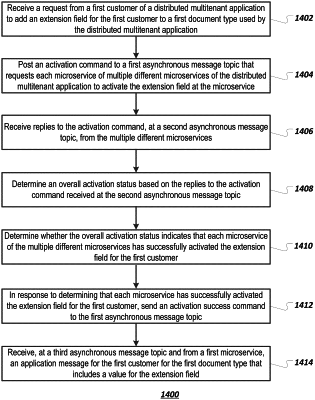| CPC H04L 67/51 (2022.05) | 20 Claims |

|
1. A computer-implemented method comprising:
receiving a request from a first customer of a distributed multitenant application to add an extension field for the first customer to a first document type used by the distributed multitenant application;
posting an activation command to a first asynchronous message topic that requests each microservice of multiple different microservices of the distributed multitenant application to activate the extension field at the microservice by enhancing, in a microservice database of the microservice, a database schema for first customer for the first document type to support the extension field for the first customer;
receiving replies to the activation command, at a second asynchronous message topic, from the multiple different microservices, wherein each reply indicates whether a respective microservice of the multiple different microservices has successfully activated the extension field at the microservice for the first customer;
determining an overall activation status based on the replies to the activation command received at the second asynchronous message topic;
determining whether the overall activation status indicates that each microservice of the multiple different microservices has successfully activated the extension field for the first customer;
in response to determining that each microservice of the multiple different microservices has successfully activated the extension field for the first customer, sending an activation success command to the first asynchronous message topic that informs the multiple different microservices that the extension field can be used for the first customer in the distributed multitenant application; and
receiving, at a third asynchronous message topic and from a first microservice, an application message for the first customer for the first document type that includes a value for the extension field.
|